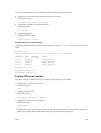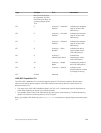
Type TLV Description
127 Protocol Identity Indicates the protocols that the
port can process. The Dell
Networking OS does not
currently support this TLV.
IEEE 802.3 Organizationally
Specific TLVs
127 MAC/PHY Configuration/Status Indicates the capability and
current setting of the duplex
status and bit rate, and whether
the current settings are the result
of auto-negotiation. This TLV is
not available in the Dell
Networking OS implementation
of LLDP, but is available and
mandatory (non-configurable) in
the LLDP-MED implementation.
127 Power via MDI Dell Networking supports the
LLDP-MED protocol, which
recommends that Power via MDI
TLV be not implemented, and
therefore Dell Networking
implements Extended Power via
MDI TLV only.
127 Link Aggregation Indicates whether the link is
capable of being aggregated,
whether it is currently in a LAG,
and the port identification of the
LAG. The Dell Networking OS
does not currently support this
TLV.
127 Maximum Frame Size Indicates the maximum frame
size capability of the MAC and
PHY.
TIA-1057 (LLDP-MED) Overview
Link layer discovery protocol — media endpoint discovery (LLDP-MED) as defined by ANSI/ TIA-1057—
provides additional organizationally specific TLVs so that endpoint devices and network connectivity
devices can advertise their characteristics and configuration information; the OUI for the
Telecommunications Industry Association (TIA) is 00-12-BB.
• LLDP-MED Endpoint Device — any device that is on an IEEE 802 LAN network edge can
communicate using IP and uses the LLDP-MED framework.
• LLDP-MED Network Connectivity Device — any device that provides access to an IEEE 802 LAN to an
LLDP-MED endpoint device and supports IEEE 802.1AB (LLDP) and TIA-1057 (LLDP-MED). The Dell
Networking system is an LLDP-MED network connectivity device.
Link Layer Discovery Protocol (LLDP)
547


















